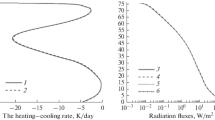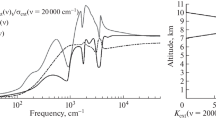Summary
Computations of solar heating and infrared cooling for clear sky conditions in the area of the Central American Seas are presented, as based on conventional radiosondes in 1960. Results are discussed with regard to latitude mean data available in the literature.
Both solar heating and infrared cooling display the most pronounced latitudinal variation in winter, while the distribution is rather uniform in summer. Large heating rates are found in the lower layers over the Caribbean Sea. The infrared cooling shows maxima around 700 mb and below the 950 mb level, in both summer and winter. This contrasts withLondon's result, but agrees with a more recent study byDavis. Infrared cooling rates computed for clear sky conditions up to 500 mb are somewhat larger than the results form radiometer soundings in fall 1960 as reported byRiehl. Discrepancies betweenRiehl's data andLondon's latitude mean values appear to result essentially from different cloud conditions. The pattern of net cooling is in general consistent withLondon's latitude mean cross-sections for average cloudiness.
Effective outgoing radiation in winter displays a decrease from the Caribbean Sea towards the cold interior of the North American Continent, while latitudinal contrasts vanish during the summer season. Computations compare well withBudyko's table andRiehl's estimate for fall 1960, while they are substantially lower thanLondon's data and estimates fromSverdrup's graph.
Zusammenfassung
Absorption von Sonnenstrahlung und langwellige Ausstrahlung für wolkenfreien Himmel wurden für den Bereich des Amerikanischen Mittelmeers berechnet, auf Grund herkömmlicher Radiosondenaufstiege im Jahre 1960. Die Ergebnisse werden mit Hinblick auf die in der Literatur verfügbaren Breitenkreismittelwerte diskutiert.
Absorption von Sonnenstrahlung und langwellige Ausstrahlung ändern sich mit der geographischen Breite besonders stark im Winter, wogegen horizontale Unterschiede im Sommer weniger ausgeprägt sind. Eine relativ starke Absorption von Sonnenstrahlung scheint in den unteren Schichten über der Karibischen See stattzufinden. Die langwellige Ausstrahlung ist besonders stark um 700 mb und unterhalb des 950 mb-Niveaus, und zwar sowohl im Sommer wie im Winter. Das steht im Gegensatz zu den Ergebnissen vonLondon, stimmt aber mit einer neueren Studie vonDavis überein. Die für wolkenfreien Himmel berechnete langwellige Ausstrahlung bis hinauf zum 500 mb-Niveau ist etwas grösser als die aus Aufstiegen von Radiometersonden im Herbst 1960 gewonnenen Werte vonRiehl. Unterschiede zwischen den Daten vonRiehl und den Breitenkreismittelwerten vonLondon scheinen im wesentlichen aus unterschiedlichen Bewölkungsverhältnissen herzurühren. Die aus Absorption und langwelliger Ausstrahlung resultierenden Abkühlungsbeträge entsprechen im allgemeinen den vonLondon für mittlere Bewölkungsverhältnisse mitgeteilten mittleren Vertikalschnitten.
Die effektive Ausstrahlung der Erdoberfläche zeigt im Winter eine Abnahme von der Karibischen See auf den dann kalten Nordamerikanischen Kontinent hin; Unterschiede mit der geographischen Breite verschwinden hingegen im Sommer. Die Berechnungen entsprechen den Tabellenwerten vonBudyko und den Abschätzungen vonRiehl für den Herbst 1960;London's Daten sowie Abschätzungen nach dem Nomogramm vonSverdrup hingegen sind deutlich höher.
Similar content being viewed by others
References
C. G. Abbot, F. E. Fowle andL. B. Aldrich,Distribution of energy in the spectra of the sun and stars, Smithsonian Miscellaneous Collections74, No. 7 (1923).
R. A. Bryson, C. W. Wilson andP. M. Kuhn,Some preliminary results from radiation sonde ascents over India., pages 507–516 in Proceedings of the WMO-IUGG Symposium on Tropical Meteorology, Rotorua, New Zealand, 5th to 13th November 1963. New Zealand Meteorological Service, Wellington N. Z. (1964).
M. I. Budyko,The heat balance of the earth's surface, (gidrometeorologischekoe izdatel'stvo Leningrad (1956), 255. English translation, USWB, Washington, D. C. (1958).
G. L. Darkow,A study of infrared radiation measurements in the vicinity of the subtropical tropopause, PhD thesis, University of Wisconsin (1964).
P. K. Das,Mean vertical motion and non-adiabatic heat sources over India, during the monsoon, Tellus14 (1962), 212.
P. A. Davis,An analysis of the atmospheric heat budgel, J. Atm. Sci.20 (1963), 5.
W. M. Elsasser,Heat transfer by infrared radiation in the atmosphere, Harvard Meteorological Studies6 (1942).
F. E. Fowle,The transparency of aqueous vapor, Astrophysical Journal42 (1915), 394.
S. Fritz andJ. S. Winston,Synoptic use of radiation measurements from satellite Tiros II, Mon. Wea. Rev.90 (1962), 1.
R. S. Hawkins,Analysis and interpretation of Tiros II infrared radiation measurements, J. Appl. Meteor.3 (1964), 564.
D. R. Johnson,The role of terrestrial radiation in the generation of available potential energy, PhD thesis, University of Wisconsin (1965).
J. C. Johnson,Physical meteorology, Technology Press of MIT and J. Wiley and Sons Inc., New York, Chapman and Hall Ltd. (London 1954).
P. M. Kuhn,Radiometersonde measurements of water vapor flux emissivity, PhD thesis, University of Wisconsin (1962).
P. M. Kuhn,Radiometersonde observations of infrared flux emissivity of water vapor, J. Appl. Meteor2 (1963), 368.
P. M. Kuhn andV. E. Suomi,Infrared radiometer soundings on a synoptic scale, J. Geophys. Res.65 (1960), 3669.
J. London,A study of the atmospheric heat balance, Final report, Contract No. AF 19(122)-165. Res. Div. College of Engineering, New York University, New York 1957).
O. Lönnquist,A general method and a simplified formula for calculating effective radiation, Arkiv för Geofysik1 (1950), 79.
A. Mani, C. R. Sreedharan andV. Srinivasan,Measurements of infrared radiative fluxes over India., J. Geophys. Res.70 (1965), 4529.
H. T. Mantis,Observation of infrared cooling of a tropical air mass, J. Geophys. Res.66 (1961), 465.
R. Mügge andF. Möller,Zur Berechnung von Strahlungsströmen und Temperaturänderungen in Atmosphären von beliebigem Aufbau, Zeitschr. Geophys.8 (1932), 53.
W. Nordberg, W. R. Bandeen, B. J. Conrath, V. Kunde andI. Persano,Preliminary results of radiation measurements from the Tiros III meteorological satellite, J. Atm. Sci.19 (1962), 20.
H. Riehl,Radiation measurements over the Caribbean during the autumn of 1960. J. Geophys. Res67 (1962), 3935.
R. R. Sabatini andV. F. Suomi,On the possibility of atmospheric infrared cooling estimates from setellite observations, J. Atm. Sci.19 (1962), 349.
V. E. Suomt, D. O. Staley andP. M. Kuhn,A direct measurement of infrared radiation divergence to 160 mb. Quart. J. Roy. Meteor. Soc.84 (1958), 134.
H. U. Sverdrup, M. W. Johnson andR. H. Fleming,The oceans (New York 1946).
Author information
Authors and Affiliations
Rights and permissions
About this article
Cite this article
Hastenrath, S.L. Computations of the tropospheric radiation budget in the Caribbean and Gulf of Mexico area for clear sky conditions. PAGEOPH 66, 140–155 (1967). https://doi.org/10.1007/BF00875320
Received:
Issue Date:
DOI: https://doi.org/10.1007/BF00875320




